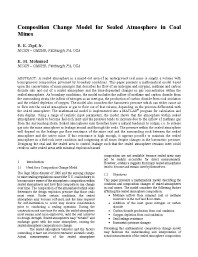Mining Publication: Composition Change Model for Sealed Atmosphere in Coal Mines
Original creation date: June 2010
Authors: RK Zipf, KM Mohamed
NIOSHTIC2 Number: 20037505
Proceedings of the 13th U.S./North American Mine Ventilation Symposium, Sudbury, Ontario, Canada, June 13-16, 2010. Hardcastle S, McKinnon DL, eds., Sudbury, Ontario, Canada: MIRARCO - Mining Innovation, 2010; :493-500
A sealed atmosphere in a mined-out area of an underground coal mine is simply a volume with homogeneous composition governed by boundary conditions. This paper presents a mathematical model based upon the conservation of mass principle that describes the flow of air (nitrogen and oxygen), methane and carbon dioxide into and out of a sealed atmosphere and the time-dependent changes in gas concentration within the sealed atmosphere. As boundary conditions, the model includes the inflow of methane and carbon dioxide from the surrounding strata, the inflow of nitrogen as an inert gas, the production of carbon dioxide from coal oxidation and the related depletion of oxygen. The model also considers the barometric pressure which can either cause air to flow into the sealed atmosphere or gas to flow out of that volume, depending on the pressure differential with the sealed atmosphere. The mathematical model is implemented into a MATLAB® program for calculation and data display. Using a range of realistic input parameters, the model shows that the atmosphere within sealed atmospheres tends to become fuel-rich inert and the pressure tends to increase due to the inflow of methane gas from the surrounding strata. Sealed atmospheres may therefore have a natural tendency to outgas, i.e. to release gas into the mine atmosphere as leakage around and through the seals. The pressure within the sealed atmosphere will depend on the leakage gas flow resistance of the mine seal and the surrounding rock between the sealed atmosphere and the active mine. If this resistance is high enough, it appears possible to maintain the sealed atmosphere in a fuel-rich inert condition and outgassing at all times despite changes in the barometric pressure. Designing the seal and the sealed area to control leakage such that the sealed atmosphere remains inert could result in safer sealed areas with minimal explosion hazard.

NIOSHTIC2 Number: 20037505
Proceedings of the 13th U.S./North American Mine Ventilation Symposium, Sudbury, Ontario, Canada, June 13-16, 2010. Hardcastle S, McKinnon DL, eds., Sudbury, Ontario, Canada: MIRARCO - Mining Innovation, 2010; :493-500
- Explosion Prevention
- Historical Development of Technologies for Controlling Methane in Underground Coal Mines
- Methane Control by Isolation of a Major Coal Panel - Pittsburgh Coalbed
- Methane Emission from U.S. Coal Mines in 1975, A Survey : A Supplement to Information Circulars 8558 and 8659
- Methane Emission from U.S. Coal Mines, A Survey
- Methane Emission Rate Studies in a Northern West Virginia Mine
- Methane Emissions from an Advancing Coal Mine Section in the Pittsburgh Coalbed
- Peak Methane Concentrations During Coal Mining: An Analysis
- Progress Toward Improved Engineering of Seals and Sealed Areas of Coal Mines
- Reservoir Rock Properties of Coal Measure Strata of the Lower Monongahela Group, Greene County (Southwestern Pennsylvania), from Methane Control and Production Perspectives
- Rotary Drilling Techniques Used in the Beckley Coalbed